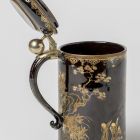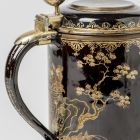
Tankard with lid - Chinoiserie, chinese lacquer painting; from the collection of Augustus II the Strong, Elector of Saxony and King of Poland
| Accession Nr.: | 5861 |
|---|---|
| Artist/Maker: |
Schnell, Martin (1675 - 1740) / glass-engraver |
| Manufacturer: | Meissen porcelain factory |
| Place of production: | Meissen |
| Techniques: | black glaze; gilded; mounted with silver gilt |
|---|---|
| Dimensions: |
height: 21,2 cm
base diameter: 11,5 cm
legnagyobb szélesség (füllel): 16 cm
|
One matchless piece in the Museum of Applied Arts’ collection is a porcelain tankard made for royalty, probably Augustus the Strong (1670–1733), Elector of Saxony and King of Poland. Even its material is exceptional – “Bottger stoneware”, which could be polished like a precious stone, with black glaze and lacquer painting. The alchemist Johann Friedrich Bottger (1682–1719) conducted experiments in Augustus’ court together with the German scientist Ehrenfried Walther von Tschirnhaus (1651–1708). One outcome of their experiments was “red stoneware” or “iron porcelain”, although their development of European hard porcelain was much more significant, and to exploit their invention, Augustus built Europe’s first porcelain factory in Meissen. The tankard’s elegant height-base proportions, the modelling and curvature of the lid, and the nobly simple form of the metal hinge direct the gaze to the decoration, one of the most outstanding works of porcelain painting ascribed to Martin Schnell (1675–1740). The lacquer-paint chinoiserie on the black glaze comprises anecdotal pictures little boys running along holding kites a noble lady and a lady-in-waiting carrying her musical instrument and military musicians with their instruments, arranged above a city gate rising behind a cliff. On the rock are grass, pines and a flowering bush, all painted with great subtlety. A Chinese boy sits on the lid of the tankard. The ornamentation around the rims consists of rows of leaves, half-palmettes, ribbons and fringes and on the outside of the handle is a rocaille rosette decoration painted in gold. The uncommonly prolific and fine painting of the tankard and its overall finesse have earned it a place in several exhibitions and publications in recent years.
Literature
- Szerk.: Horváth Hilda, Szilágyi András: Remekművek az Iparművészeti Múzeum gyűjteményéből. (Kézirat). Iparművészeti Múzeum, Budapest, 2010. - Nr. 75. (Balla Gabriella)
- Szerk.: Pataki Judit: Az idő sodrában. Az Iparművészeti Múzeum gyűjteményeinek története. Iparművészeti Múzeum, Budapest, 2006. - Nr. 114.
- Kopplin Monika, Haase Gisela: Sächßisch Lacquitre Sachen: Lackkunst in Dresden unter August dem Starken. Museum für Lackkunst, Münster, 1998. - 14., 79. p.
- Szerk.: Lovag Zsuzsa: Az Iparművészeti Múzeum. (kézirat). Iparművészeti Múzeum, Budapest, 1994. - Nr. SZ/72.
- Szerk.: Szilágyi András, Péter Márta: Barokk és rokokó. Az európai iparművészet stíluskorszakai. Iparművészeti Múzeum, Budapest, 1990. - Nr. 6.132. (Katona Imre)
- Nékám Lajosné: Meisseni porcelán a Budapesti Iparművészeti Múzeum gyűjteményében. Corvina Kiadó, Budapest, 1980. - Nr. 1.
- Szerk.: Dobrovits Aladár: Höroldt és műhelyének meisseni porcelánjai magyar gyűjteményekben. Az Iparművészeti Múzeum Évkönyvei I, 1954. Tankönyvkiadó Vállalat, Budapest, 1954. - 126. (Pataky Dénesné)
- Sammlung des Königl. ungar. Hofrats Gustav von Gerhardt, Budapest. Versteigerung. I. Kunstgewerbe. Rudolph Lepke's Kunst-Auctions-Haus, Berlin, 1911.


